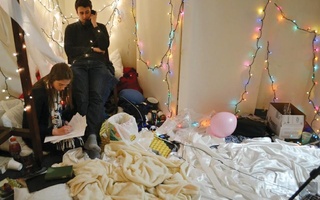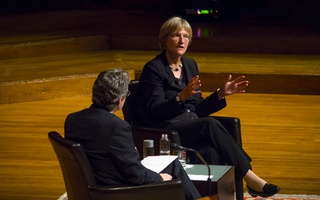At one minute after midnight on the morning of Thursday, Jan. 19, Avery Leonard ’14 and Eric R. Brewster ’14 started off a friendly phone chat like so many other casual conversations: They talked about the weather. Any semblance of conversational normalcy ended there. Over the course of their discussion, the pair was taunted, caressed, insulted, harassed, massaged, pelted with towels, drawn on and even flashed, sometimes by complete strangers. By the time they finally hung up the phone, over 46 hours later, a world record had potentially been broken in a project that hoped to challenge traditional practices of performance and social norms of conversation. With this performance art piece, entitled “(for the purpose of catching ourselves in the act of being the most),” the Harvard Generalist made its debut.
The group’s founding members first began meeting in the basement of Holworthy more than a year ago. Leonard and Brewster were among a group of then-freshmen that gathered to discuss issues ranging from art to their expectations for college to observations of social intolerance. “It was this collaborative environment where we brought all these people from different academic and extracurricular arenas and collected them together into this sort of brain trust,” Generalist member Tyler M. Richard ’14 says.
The members became close friends, and their conversations delved for hours into the abstract and hypothetical. “It’s the kind of thing a certain kind of person becomes addicted to,” Leonard says.
Hailing from a variety of artistic and academic backgrounds, the future members of the Generalist all shared the desire to turn their artistically experimental discussions into something they could share with the world. “Our group always rallied around having wild, fun, absurd artistic ambitions,” Ginny C. Fahs ’14 says. They decided in the fall of 2011 to realize these ambitions with the Generalist—so named, Mariel N. Pettee ’14 explains, to signify the diversity of artistic capabilities represented by the group’s members. In keeping with their collaborative ethic, the Generalist functions as a collective, making decisions and authoring their projects all together with no strict power hierarchy.
The members also felt Harvard had an artistic niche that needed to be filled. “Looking around the extracurricular community at Harvard, there are a ton of arts organizations, there are a ton of writing organizations, there are literary or performance organizations, but we noticed there was one gaping hole, which I guess you could call social installation art,” Brewster says.
The Generalist’s work is meant to play with the traditional division between performer and audience. “As audience members, there are so many times when we want to clap or express some sort of outward expression of how we’re feeling or how it’s affecting us, but typically we’re expected to mostly remain silent,” says Pettee, who directed the debut performance.
Rather than demanding passive observation, installations of this sort are designed so audience members can play an active role and express themselves, thereby also making art more accessible. “That’s a tone we hope to strike, that we can be playing with this community and inspiring a conversation rather than having art be this distanced thing that people feel like they can’t talk to or about because they feel like they don’t have the capacity to understand it,” Fahs says.
But Generalist members also hope their pieces lead participants to reexamine social conventions and common interactions, like phone calls. “For two days continuously, people are coming in, they’re interacting with each other, and they’re having conversations, and they’re experimenting with new social norms because the context in which they’re having these interactions is so strange,” Leonard says of the debut piece.
In that vein, the group plans to create installations that replicate everyday social situations but push the audience to understand them in new ways. “At Harvard, everyone has their own opinions, their own lives, their own 6,000 activities, and all we really strive to do is make people think,” Brewster says.
Richard relates their first performance to idea of the “gesamtkunstwerk,” or total work of art. “It embodies the ethos of the [Generalist],” he says.
The performance was playful and interactive while defying standard performance practices and making a subtle statement about contemporary culture’s exploitative emphasis on competition. “I think it was a really good first project for us just because it’s such a ridiculous, over-the-top, ambitious feat that it’ll really get our name out there,” Pettee says. “If we have more of a presence on campus, people might realize that art is such a universal thing—it really makes us human in a lot of ways.”
—Staff writer Rebecca J. Mazur can be reached at rmazur@college.harvard.edu.
Read more in Arts
Michaelson Returns With Sophistication and FinesseRecommended Articles
-
Tsunami Spurs Student to ActionKelsey T. Leonard ’10 was on her way to work Tuesday when she learned, in a text message from her ...
-
 Student Art Group Dials In World's Longest Phone Call
Student Art Group Dials In World's Longest Phone Call -
 The Chickwich Challenge
The Chickwich Challenge -
Croquet Places Fifth at NationalsThis year, the historic game of croquet was restored to Harvard’s athletic fields, and the young team has already catapulted to success on a national scale. The recently re-founded Harvard croquet team competed in the national tournament this past weekend, placing fifth in the country.
-
Researchers Praise Response to Marathon BombingResearchers at the Harvard Kennedy School praised the efficacy of the response by medical and law enforcement officials to the Boston Marathon bombings in a paper published last week by the school’s Program on Crisis Leadership.
-
 Faust Charts Course Through ‘Stormy Seas’ as The Harvard Campaign Approaches
Faust Charts Course Through ‘Stormy Seas’ as The Harvard Campaign Approaches













